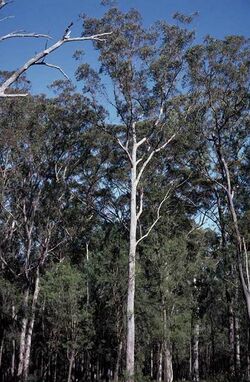Biology:Eucalyptus sphaerocarpa
| Blackdown stringybark | |
|---|---|

| |
| Eucalyptus sphaerocarpa near Blackdown | |
| Scientific classification | |
| Kingdom: | Plantae |
| Clade: | Tracheophytes |
| Clade: | Angiosperms |
| Clade: | Eudicots |
| Clade: | Rosids |
| Order: | Myrtales |
| Family: | Myrtaceae |
| Genus: | Eucalyptus |
| Species: | E. sphaerocarpa
|
| Binomial name | |
| Eucalyptus sphaerocarpa L.A.S.Johnson & Blaxell[1]
| |
Eucalyptus sphaerocarpa, commonly known as the Blackdown stringybark,[2] is a species of tall forest tree that is endemic to Queensland. It has rough, stringy bark on the trunk and branches, lance-shaped to curved adult leaves, flower buds in groups of seven, nine or eleven, white flowers and shortened spherical fruit.
Description
Eucalyptus sphaerocarpa is a tree that typically grows to a height of 45 m (148 ft) and forms a lignotuber. It has rough, grey to brownish, stringy bark on the trunk and branches. Young plants and coppice regrowth have stems that are square in cross-section and dull greyish green leaves that are paler on the lower surface, elliptic to lance-shaped, 90–190 mm (3.5–7.5 in) long and 25–60 mm (0.98–2.36 in) wide. Adult leaves are the same shade of green to greyish on both sides, lance-shaped to curved, 75–150 mm (3.0–5.9 in) long and 12–35 mm (0.47–1.38 in) wide, tapering to a petiole 10–37 mm (0.39–1.46 in) long. The flower buds are arranged in leaf axils in groups of seven, nine or eleven on a flattened, unbranched peduncle 10–18 mm (0.39–0.71 in) long, the individual buds on pedicels 3–6 mm (0.12–0.24 in) long. Mature buds are oval, 7–9 mm (0.28–0.35 in) long and 4–5 mm (0.16–0.20 in) wide with a conical operculum. Flowering has been recorded in September and the flowers are white. The fruit is a woody, shortened spherical capsule 9–12 mm (0.35–0.47 in) long and 10–13 mm (0.39–0.51 in) wide with the valves below rim level.[2][3]
Taxonomy and naming
Eucalyptus sphaerocarpa was first formally described in 1972 by Lawrie Johnson and Donald Blaxell in Contributions from the New South Wales Herbarium from specimens collected from the Blackdown Tableland.[4] The specific epithet (sphaerocarpa) is derived from ancient Greek words meaning "spherical" and "fruit", referring to the shape of the fruit.[5][2]
Distribution and habitat
Blackdown stringybark grows in tall, open forest and is restricted to the Blackdown Tableland west of Rockhampton.
Conservation status
This eucalypt is classified as "least concern" under the Queensland Government Nature Conservation Act 1992.[6]
See also
External links
Farm Forestry New Zealand, Eucalyptus sphaerocarpa, my favourite durable timber species
References
- ↑ "Eucalyptus sphaerocarpa". Australian Plant Census. https://biodiversity.org.au/nsl/services/apc-format/display/92933.
- ↑ 2.0 2.1 2.2 "Eucalyptus sphaerocarpa". Euclid: Centre for Australian National Biodiversity Research. https://apps.lucidcentral.org/euclid/text/entities/eucalyptus_sphaerocarpa.htm.
- ↑ Chippendale, George M.. "Eucalyptus sphaerocarpa". Australian Biological Resources Study, Department of the Environment and Energy, Canberra. https://profiles.ala.org.au/opus/foa/profile/Eucalyptus%20sphaerocarpa.
- ↑ "Eucalyptus sphaerocarpa". APNI. https://id.biodiversity.org.au/instance/apni/455433.
- ↑ William T. Stearn (1992). Botanical Latin. History, grammar, syntax, terminology and vocabulary (4th ed.). Portland, Oregon: Timber Press. p. 499.
- ↑ "Blackdown stringybark - Eucalyptus sphaerocarpa". WetlandInfo. Queensland Government. http://wetlandinfo.ehp.qld.gov.au/wetlands/ecology/components/species/?eucalyptus-sphaerocarpa.
Wikidata ☰ Q15356041 entry
 |



